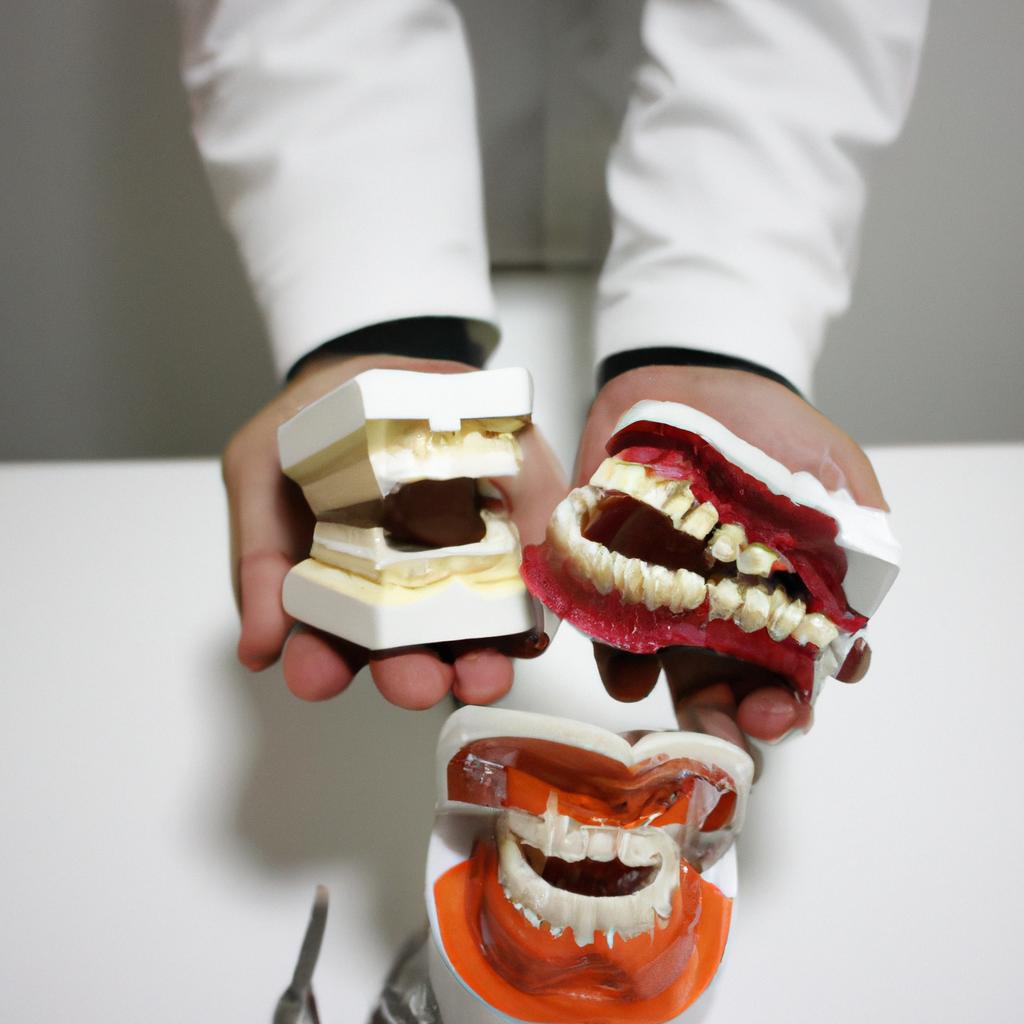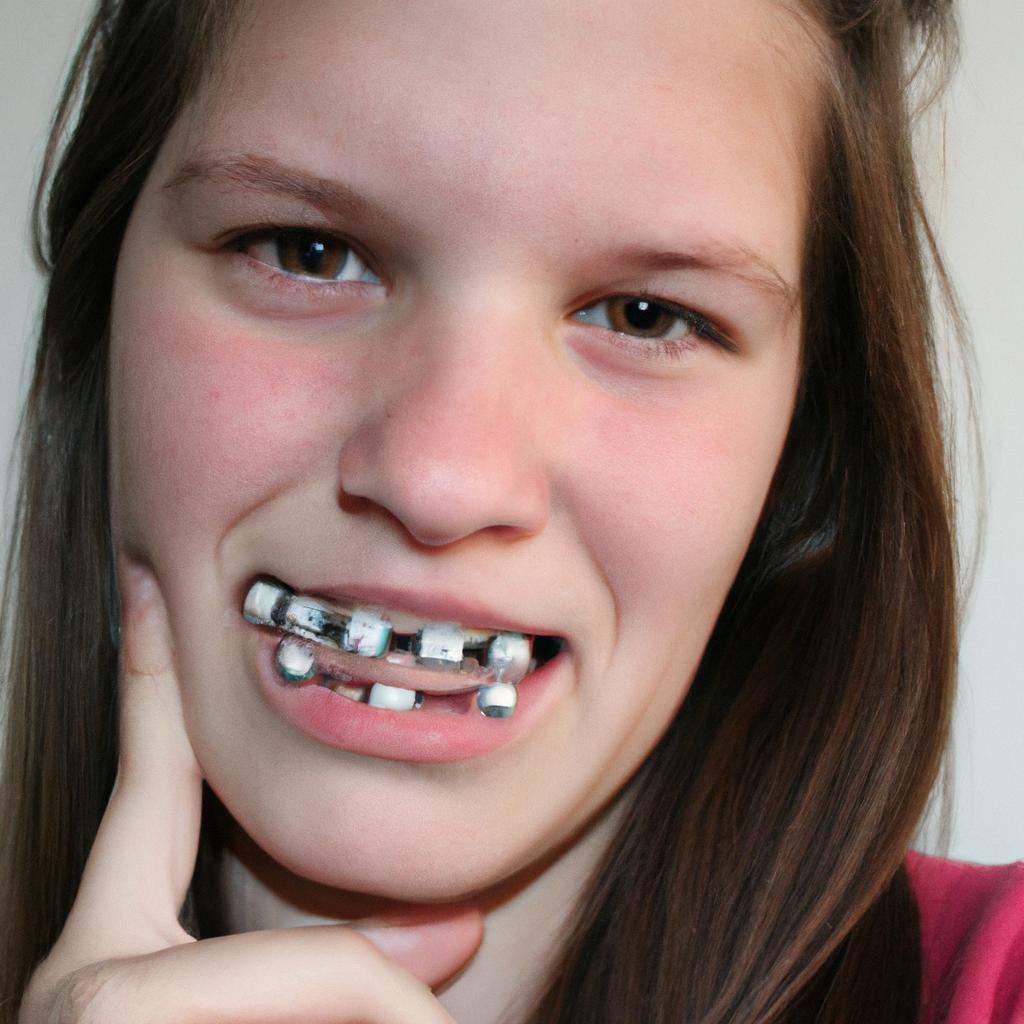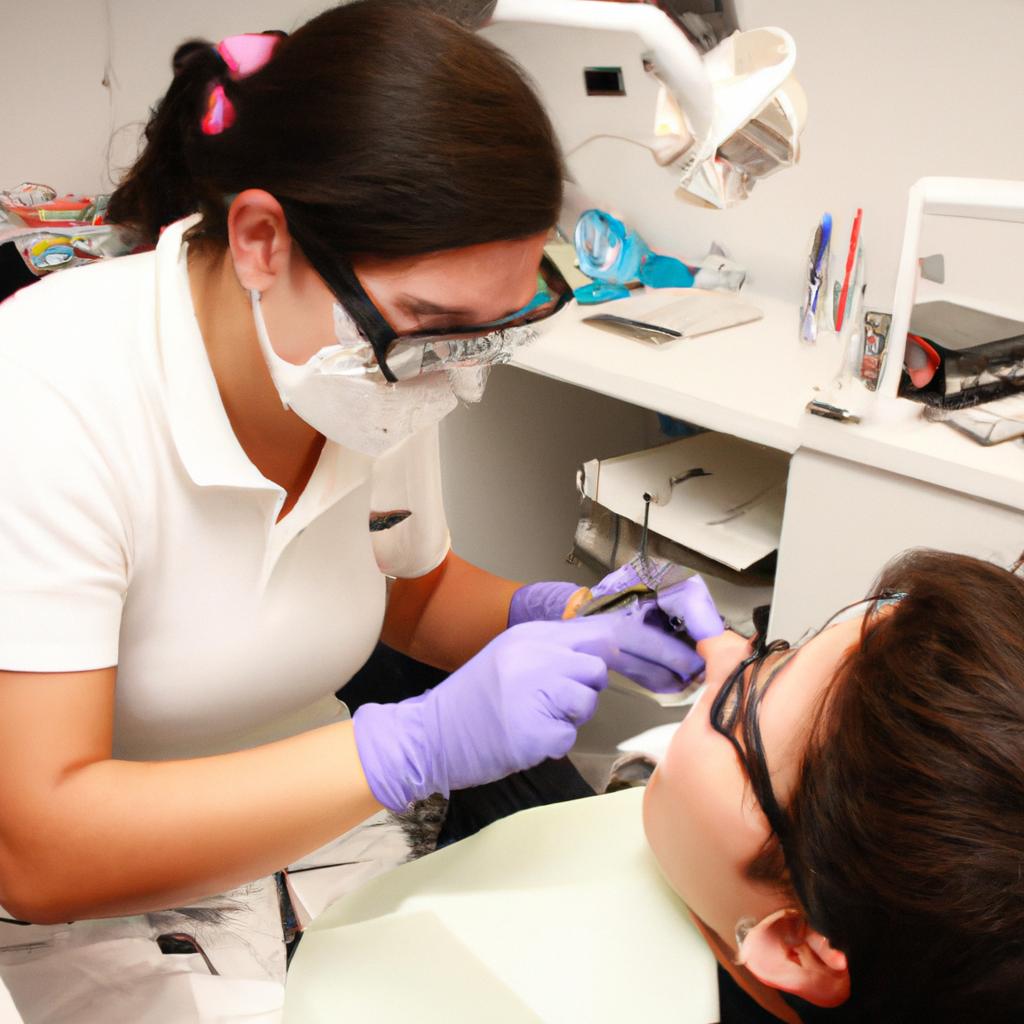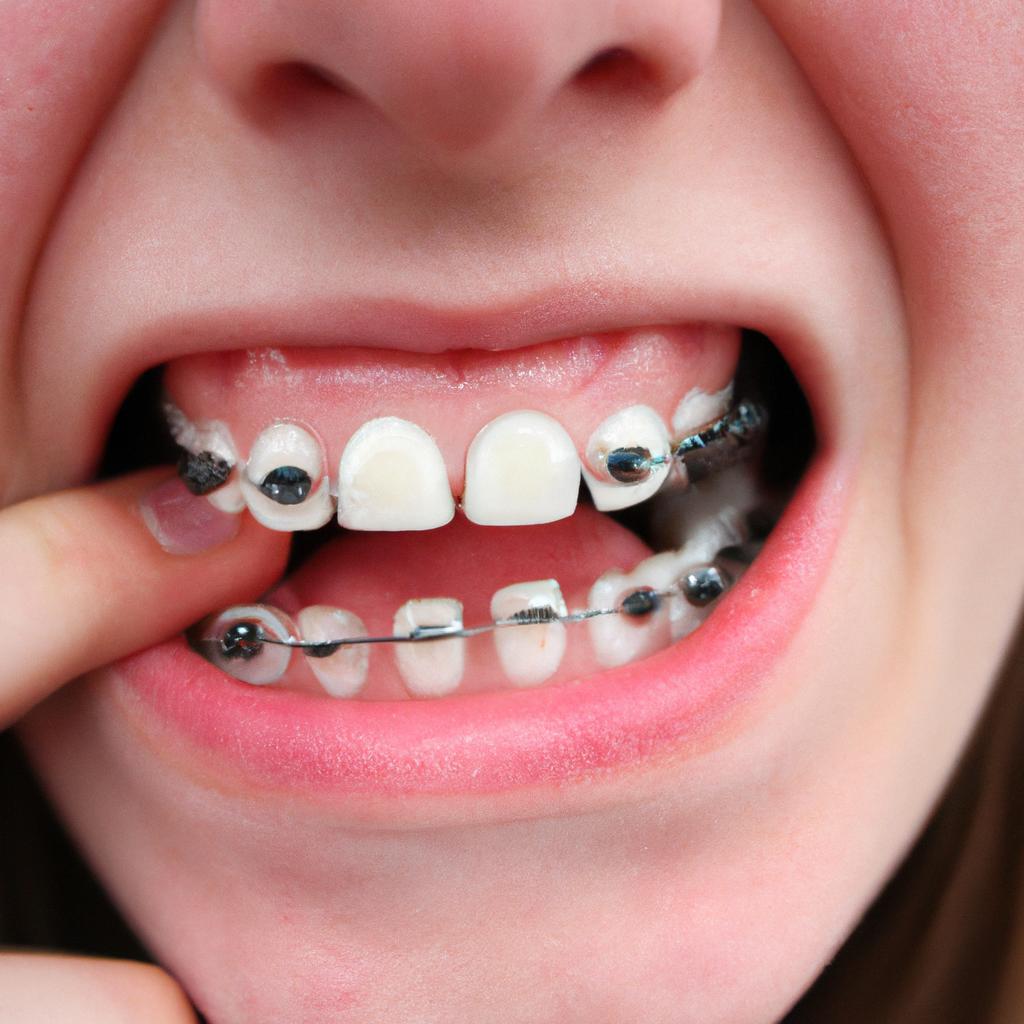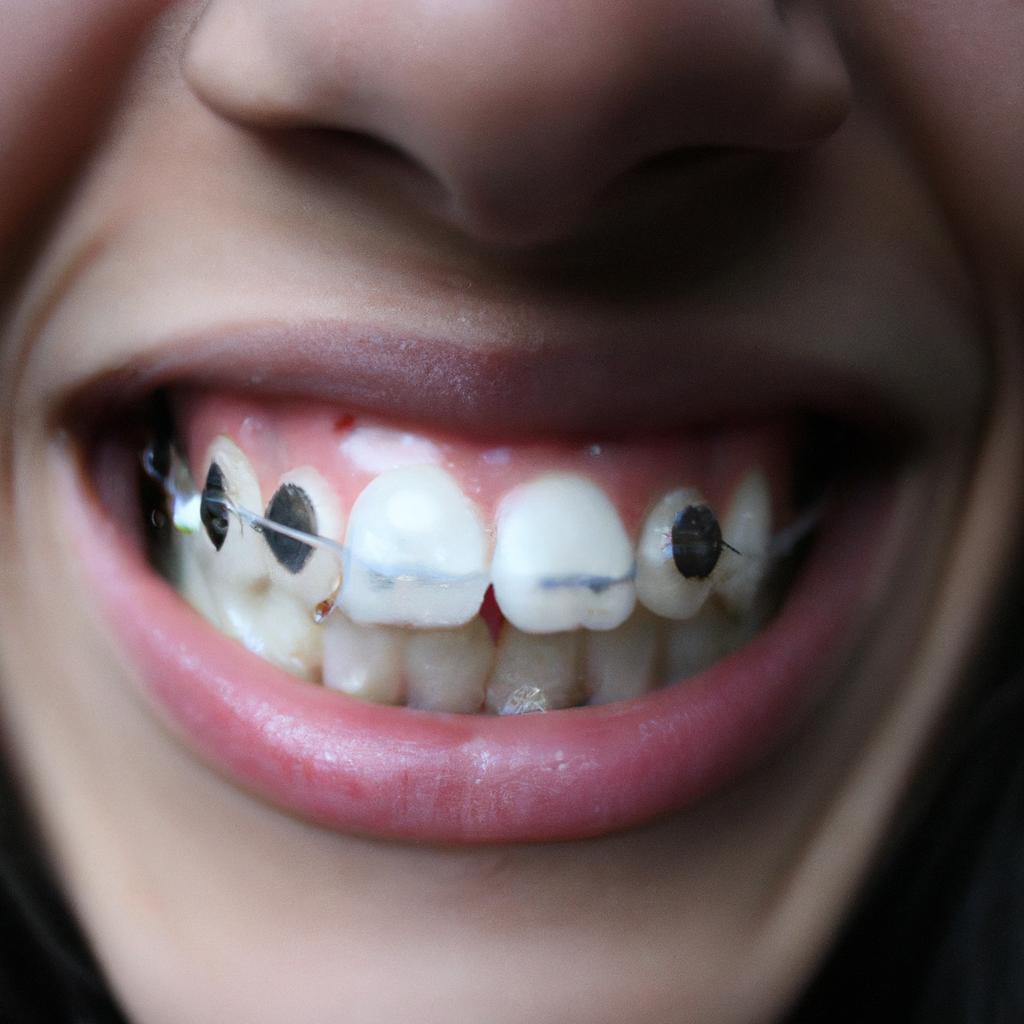Orthodontic Appliances in Orthodontics: A Comprehensive Guide
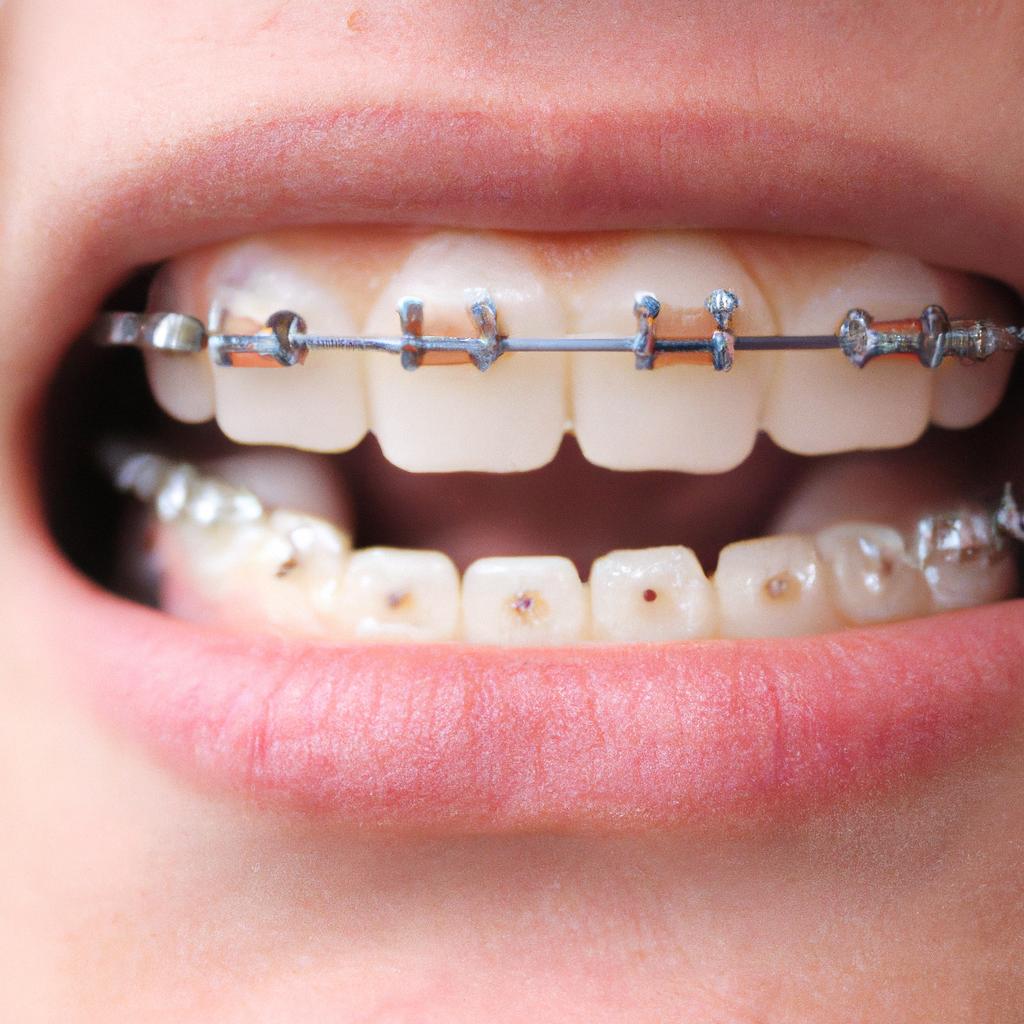
Orthodontic appliances play a crucial role in the field of orthodontics, serving as integral tools for correcting dental irregularities and achieving optimal oral health. These devices are designed to guide teeth into their proper positions and correct any misalignments or malocclusions that may be present. For instance, consider the case study of a 14-year-old patient with severe crowding and protrusion of the upper front teeth. Through the use of various orthodontic appliances such as braces or aligners, this individual’s dental issues were successfully addressed, resulting in improved aesthetics, function, and overall well-being.
Understanding the different types of orthodontic appliances available is essential for both clinicians and patients alike. This comprehensive guide aims to provide an overview of various orthodontic appliances commonly used in contemporary orthodontic practice. The article will delve into detailed descriptions of fixed appliances like braces (both metal and ceramic), removable appliances such as clear aligners, functional appliances including headgear and Forsus springs, as well as other specialized options like palatal expanders. By exploring these diverse treatment modalities, readers will gain valuable insights into how each appliance functions, its indications for use, potential advantages and limitations, as well as considerations related to patient compliance during treatment and maintenance of oral hygiene.
Braces, both metal and ceramic, are the most commonly used fixed orthodontic appliances. Metal braces consist of brackets that are bonded to the teeth and connected by archwires, which apply gentle pressure to move the teeth into proper alignment. Ceramic braces work similarly but use tooth-colored or clear brackets for a more aesthetically pleasing appearance.
Clear aligners, such as Invisalign, are popular removable orthodontic appliances. They are custom-made trays that fit snugly over the teeth and exert gentle forces to shift them gradually. Clear aligners offer advantages of being virtually invisible, comfortable, and easily removable for eating and cleaning purposes.
Functional appliances like headgear or Forsus springs are used to correct skeletal discrepancies in growing patients. Headgear consists of an external appliance that applies force to the jawbone to influence growth and tooth movement. Forsus springs are internal devices attached to braces, helping correct overbites or underbites without the need for headgear.
Palatal expanders are specialized appliances used to widen the upper jaw in cases of narrow dental arches or crossbites. These devices apply gentle pressure on the palate, gradually expanding it over time.
It is important to note that each appliance has its own indications and limitations depending on specific patient needs. Factors such as age, severity of malocclusion, patient cooperation, and oral hygiene habits must be considered when selecting the appropriate orthodontic appliance for treatment.
Patient compliance plays a crucial role in achieving successful outcomes with orthodontic appliances. Proper wear-time (for removable appliances) or maintaining good oral hygiene (for all types) is essential for effective treatment progress. Patients should follow their orthodontist’s instructions diligently regarding wearing times, avoiding certain foods that may damage the appliance, attending regular appointments for adjustments or monitoring progress.
In conclusion, understanding different types of orthodontic appliances provides valuable insights into their functions, indications, advantages, limitations, and considerations related to patient compliance. By working closely with an orthodontist, patients can achieve optimal oral health and aesthetic outcomes through the appropriate use of these appliances.
Types of Orthodontic Appliances
Orthodontic appliances play a crucial role in the field of orthodontics, assisting in the correction of dental irregularities and achieving optimal oral health and aesthetics. These appliances encompass a wide range of devices that are specifically designed to address various malocclusions and align teeth. Understanding the different types of orthodontic appliances is essential for both clinicians and patients seeking orthodontic treatment.
To illustrate the significance of these appliances, let us consider an example scenario: A 14-year-old patient presents with crowded incisors, resulting in a misaligned bite and compromised facial esthetics. In such cases, orthodontists often recommend the use of fixed or removable orthodontic appliances to correct these issues effectively.
One way to categorize orthodontic appliances is by their mode of application. Fixed appliances, also known as braces, consist mainly of brackets bonded directly onto the tooth surface accompanied by archwires that apply controlled forces over time to move teeth into proper alignment. Removable appliances, on the other hand, can be removed from the mouth by patients themselves and are commonly used for mild-to-moderate dental irregularities.
The choice between fixed and removable appliances depends on several factors including treatment objectives, severity of malocclusion, patient compliance, and overall clinical considerations. It is important to note that each type has its advantages and limitations; thus, it is imperative for orthodontists to carefully assess individual cases before determining which appliance would yield optimal results.
In summary, understanding the diverse array of orthodontic appliances is fundamental in providing effective treatments for individuals with dental irregularities. The decision regarding whether to use fixed or removable appliances should be based on careful consideration of multiple factors unique to each patient’s case. In the following section, we will delve deeper into one specific category within fixed appliances: traditional braces.
Emotional Bullet Point List
- Improved self-confidence
- Enhanced functionality of teeth and jaws
- Reduced risk of dental decay and gum disease
- Enhanced overall facial aesthetics
Emotional Table
| Orthodontic Appliances | Advantages | Limitations |
|---|---|---|
| Fixed appliances | Precise control over tooth movement | Difficulty in oral hygiene maintenance |
| Removable appliances | Easy to clean and maintain | Limited treatment options for complex cases |
Moving forward, we will explore the characteristics and benefits of traditional braces without transition phrases.
Traditional Braces
In the previous section, we explored the various types of orthodontic appliances commonly used in orthodontics. Now, let us delve deeper into one specific type: traditional braces. To illustrate their effectiveness, consider a hypothetical case study involving a 15-year-old patient named Sarah.
Sarah presented with severe crowding and misalignment of her teeth. After careful evaluation by an experienced orthodontist, it was decided that traditional braces would be the most suitable treatment option for her particular case. Traditional braces consist of metal brackets bonded to each tooth’s surface and interconnected by archwires which are periodically adjusted to facilitate tooth movement.
The benefits of using traditional braces extend beyond just correcting dental malocclusions. They also enhance oral health and overall well-being. Here are some key advantages:
- Improved aesthetics: While many patients initially have concerns about the appearance of braces, modern advancements have made them more discreet than ever before.
- Enhanced functionality: By aligning the bite and positioning the teeth correctly, traditional braces improve chewing efficiency and reduce the risk of temporomandibular joint disorders.
- Increased self-confidence: As treatment progresses and noticeable improvements become evident, patients often experience heightened self-esteem and confidence in social interactions.
- Long-term stability: Following completion of treatment, proper use of retainers ensures long-lasting results and prevents any relapse or regression.
Let us now examine a table comparing different aspects between traditional braces and other orthodontic appliances:
| Aspect | Traditional Braces | Alternative Appliance |
|---|---|---|
| Aesthetics | Metal brackets visible | Clear or ceramic options |
| Treatment duration | Typically longer | Varied depending on method |
| Adjustability | Frequent adjustments | Less frequent adjustments |
| Cost | Generally more affordable | May be more expensive |
As we can see, traditional braces have their distinct advantages and disadvantages compared to alternative orthodontic appliances. However, it is crucial to consult with an experienced orthodontist who will guide patients in choosing the most appropriate treatment option based on individual needs and preferences.
Transitioning into the subsequent section about “Clear Aligners,” let us now explore another popular type of orthodontic appliance that offers a more discreet approach to teeth straightening.
Clear Aligners
Section H2: Clear Aligners
Clear aligners have gained popularity in recent years as an alternative to traditional braces for orthodontic treatment. This innovative approach utilizes a series of custom-made, transparent aligner trays that gradually move the teeth into their desired positions. One example of such clear aligners is Invisalign, which has become widely recognized and used by orthodontists worldwide.
One advantage of clear aligners is their aesthetic appeal. Unlike traditional braces, these virtually invisible trays are hardly noticeable when worn, allowing individuals to undergo orthodontic treatment without feeling self-conscious about their appearance. Moreover, clear aligners can be easily removed for activities such as eating or brushing teeth, offering greater convenience compared to fixed appliances.
While clear aligners represent a significant advancement in orthodontics, it’s important to consider certain factors before opting for this treatment method:
- Compliance: The success of clear aligner therapy relies heavily on patient compliance. It is crucial that patients diligently wear the aligners for the recommended amount of time each day.
- Treatment duration: Although the overall treatment time may vary depending on individual cases, some complex malocclusions might require longer treatment durations with clear aligners than with traditional braces.
- Cost: Clear aligner treatments tend to be more expensive than conventional braces due to the advanced technology involved in designing and manufacturing customized trays.
- Treatment limitations: Not all types of dental misalignments can be effectively corrected using clear aligners alone. Severe cases may still necessitate other adjunctive orthodontic procedures.
To provide a visual representation of the differences between traditional braces and clear aligners, refer to the following table:
| Aspect | Traditional Braces | Clear Aligners |
|---|---|---|
| Appearance | Noticeable metal brackets and wires | Virtually invisible |
| Removability | Non-removable during treatment | Removable for eating and oral hygiene |
| Dietary restrictions | Certain foods need to be avoided | No dietary restrictions |
| Oral hygiene | Requires extra effort for cleaning | Easier maintenance |
In summary, clear aligners offer a discreet and flexible orthodontic treatment option. However, their effectiveness depends on patient compliance and the complexity of the dental misalignment. It is essential for individuals considering clear aligner therapy to consult with an experienced orthodontist who can assess their specific case and determine if this approach is suitable.
Transitioning into the subsequent section about “Functional Appliances,” it should be noted that while clear aligners are effective in correcting certain types of malocclusions, they may not be appropriate for cases requiring functional appliances to address underlying skeletal discrepancies.
Functional Appliances
Section H2: Functional Appliances
Transitioning from the previous section on clear aligners, functional appliances play a significant role in orthodontic treatment. These appliances are commonly used to address skeletal discrepancies and improve facial aesthetics by manipulating growth patterns during the development of an individual’s dentofacial complex. To illustrate their effectiveness, consider the case study of a 12-year-old patient with a Class II malocclusion.
In this particular case, the patient presented with excessive overjet and a retrusive mandible. The orthodontist decided to implement a functional appliance as part of the treatment plan. By utilizing a Herbst appliance, which consists of intraoral rods connected to fixed brackets on upper and lower teeth, forces were applied to stimulate mandibular advancement. Over time, this led to improved jaw relations and reduced overjet in the patient.
Functional appliances offer several advantages in orthodontic treatment:
- They help correct skeletal discrepancies early in adolescence when growth potential is still present.
- They promote favorable changes in both dental and skeletal structures through controlled stimulation of growth centers.
- They can enhance profile aesthetics by improving lip posture and overall facial harmony.
- They may reduce or eliminate the need for extractions by creating additional space within the arches.
To better understand different types of functional appliances commonly utilized in orthodontics, refer to Table 1 below:
| Functional Appliance | Mechanism | Indication |
|---|---|---|
| Herbst | Mandibular advancement | Correction of Class II malocclusions |
| Twin Block | Simultaneous repositioning of jaws | Correction of Class II malocclusions |
| Forsus | Fixed intermaxillary elastics | Corrects various malocclusions |
| MARA | Combination of Herbst and Jasper Jumping Elastic | Treatment of Class II malocclusions |
Table 1: Common Functional Appliances and Their Indications.
In summary, functional appliances are essential tools in orthodontics for addressing skeletal discrepancies and achieving harmonious facial aesthetics. By utilizing these appliances early on during adolescence, orthodontists can effectively guide dentofacial growth and provide long-term stability to the patient’s occlusion. Moving forward, we will explore another important type of orthodontic appliance known as palatal expanders.
Transitioning into the subsequent section about “Palatal Expanders,” let us now delve into their role in widening dental arches and enhancing overall treatment outcomes.
Palatal Expanders
Functional appliances are a crucial component of orthodontic treatment, designed to correct skeletal discrepancies and encourage proper growth and development of the jaws. One example that highlights their effectiveness is the case of a 12-year-old patient who presented with a Class II malocclusion characterized by an overjet of 8mm and a retrusive mandible. After careful evaluation, it was determined that functional appliances would be the most appropriate approach to address these concerns.
The use of functional appliances offers several advantages in orthodontic practice:
-
Correcting Skeletal Imbalances: Functional appliances help stimulate favorable jaw growth patterns, particularly in patients with retrognathic (retrusive) mandibles or prognathic (protruded) maxillas. By applying controlled forces on specific areas, such as the chin or upper jaw, these appliances can modify bone position and ultimately achieve better facial harmony.
-
Enhancing Facial Aesthetics: As functional appliances promote favorable growth patterns, they can also improve overall facial aesthetics by harmonizing the relationship between the upper and lower jaws. This not only enhances the appearance but also contributes to optimal functioning of the teeth and temporomandibular joint.
-
Facilitating Orthodontic Correction: In some cases, functional appliance therapy may serve as a preliminary phase before fixed braces are applied. By addressing underlying skeletal discrepancies early on, subsequent tooth movements become more straightforward and efficient during conventional orthodontic treatment.
-
Potential Long-Term Stability: Research suggests that using functional appliances at an appropriate stage can lead to stable outcomes even after their removal. Properly aligning the jaws early on reduces reliance on compensatory dental movements later in treatment, which can contribute to long-term stability post-orthodontics.
| Advantages of Functional Appliances |
|---|
| Corrects Skeletal Imbalances |
In summary, functional appliances play a vital role in addressing skeletal discrepancies and promoting proper jaw growth. By utilizing these devices, orthodontists can achieve improved facial aesthetics, correct imbalances early on, and set the stage for successful long-term stability.
Understanding the significance of functional appliances provides a foundation for recognizing the importance of retainers in maintaining orthodontic results over time.
Retainers and Their Importance
Following the discussion on palatal expanders, we now turn our attention to another crucial aspect of orthodontic treatment – retainers. Retainers play a vital role in maintaining the results achieved through various orthodontic appliances, ensuring long-term stability and preventing relapse.
Retainers are custom-made devices typically made of plastic or metal that are designed to hold teeth in their corrected positions after active orthodontic treatment. Let us consider a hypothetical case study to illustrate the importance of retainers. Imagine a patient named Sarah who recently completed her orthodontic treatment for correcting misaligned teeth using braces. Without proper use of retainers, there is a risk that Sarah’s teeth may gradually shift back towards their original positions over time, negating all the progress made during treatment.
The significance of retainers can be understood by considering the following points:
- Stability: Retainers aid in stabilizing teeth in their desired positions, allowing the surrounding tissues to adapt and secure them.
- Prevention of Relapse: By providing continuous support, retainers help prevent any potential relapse that could occur due to natural factors like age-related changes or habits such as thumb sucking.
- Bite Adjustment: In some cases, retainers also assist in fine-tuning occlusion (bite) alignment post-treatment.
- Patient Compliance: Proper retainer wear and maintenance require patient compliance and commitment, reinforcing good oral hygiene practices while fostering discipline and responsibility.
To further emphasize the significance of wearing retainers diligently, let us take a look at this table showcasing statistics related to relapse rates among patients who did not consistently use their prescribed retainers:
| Time Since Orthodontic Treatment | Percentage of Patients Experiencing Relapse |
|---|---|
| 1 year | 25% |
| 5 years | 50% |
| 10 years | 70% |
| 20 years | 90% |
These statistics highlight the importance of consistent retainer use to maintain long-term orthodontic results. Adhering to the prescribed wearing schedule, be it full-time or part-time wear, is crucial in preventing relapse.
In summary, retainers are indispensable components of orthodontic treatment. By providing stability and preventing relapse, they ensure that the desired outcomes achieved through various orthodontic appliances remain intact over time. Patient compliance and adherence to wearing schedules play key roles in maintaining lasting results. It is essential for both patients and practitioners to recognize the significance of retainers as an integral part of comprehensive orthodontic care.

